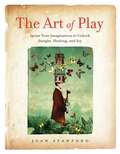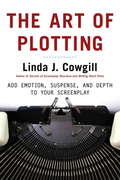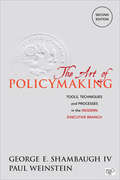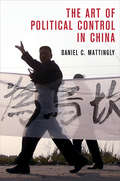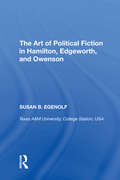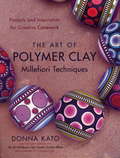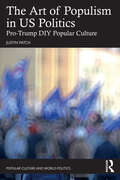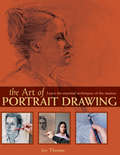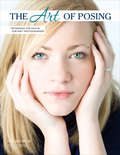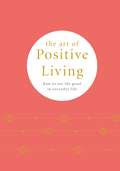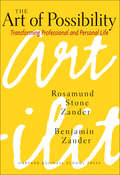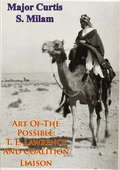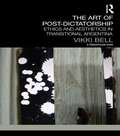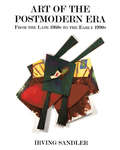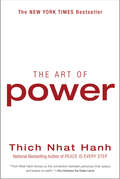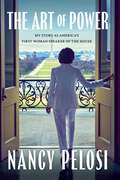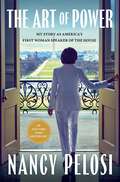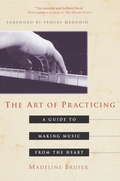- Table View
- List View
The Art of Play: Ignite Your Imagination to Unlock Insight, Healing, and Joy
by Joan StanfordAt forty-two, Joan Stanford—a busy mother, innkeeper—discovered, to her surprise and delight, a creative process for insight and healing that allowed even her, a self-proclaimed &“non-artist,&” to start making art. In The Art of Play, Stanford shares her journey through art and poetry as an example of how taking—or, more appropriately, making—time to pay attention to the imagery our daily lives presents to us can expand our awareness and joy, and she offers readers suggestions for how to do this for themselves, inviting them to embark on their own journey.
The Art of Plotting: How to Add Emotion, Excitement, and Depth to Your Writing
by Linda J. CowgillPlot must be as much about the emotions of the characters as it is about the events of the story. That's the message of The Art of Plotting, which teaches screenwriters how to integrate plot, characterization, and exposition to make stories compelling. Using examples from recent and classic movies, author Linda J. Cowgill demonstrates how the plot springs naturally from the characters--and how that technique makes audiences connect with the story on a more intimate level. Easy exercises reveal common plot problems and help writers overcome them.
The Art of Policymaking: Tools, Techniques and Processes in the Modern Executive Branch
by George Shambaugh Paul J. WeinsteinThe Art of Policymaking: Tools, Techniques and Processes in the Modern Executive Branch, Second Edition is a practical introduction to the specific tools, techniques, and processes used to create policy in the executive branch of the U.S. government. George E. Shambaugh, IV and Paul Weinstein, Jr. explain how government officials craft policy, manage the policymaking process, and communicate those policies to stakeholders and the public at large. The authors draw on both their academic and government experience to provide real-world advice on writing memos, preparing polling questions, and navigating the clearance process. An abundance of case studies show how actual policies are developed and how and why policies and processes differ across administrations. Practice scenarios allow students to apply the tools and techniques they have learned by working through both domestic and foreign policy situations.
The Art of Policymaking: Tools, Techniques and Processes in the Modern Executive Branch
by George Shambaugh Paul J. WeinsteinThe Art of Policymaking: Tools, Techniques and Processes in the Modern Executive Branch, Second Edition is a practical introduction to the specific tools, techniques, and processes used to create policy in the executive branch of the U.S. government. George E. Shambaugh, IV and Paul Weinstein, Jr. explain how government officials craft policy, manage the policymaking process, and communicate those policies to stakeholders and the public at large. The authors draw on both their academic and government experience to provide real-world advice on writing memos, preparing polling questions, and navigating the clearance process. An abundance of case studies show how actual policies are developed and how and why policies and processes differ across administrations. Practice scenarios allow students to apply the tools and techniques they have learned by working through both domestic and foreign policy situations.
The Art of Policymaking: Tools, Techniques, and Processes in the Modern Executive Branch
by George Shambaugh Paul J. WeinsteinThe Art of Policymaking is the only book designed to provide students and practitioners with a detailed explanation of the specific tools, techniques, and processes used to create policy in the U.S., as well as the tools they need to understand them. The book includes practical advice on how to write memos, prepare polling questions, and navigate the clearance process. Case studies show how actual policies were developed and how and why policies and processes differed across administrations. And scenarios allow students to practice the tools and techniques they have learned by working through both domestic and foreign policy situations. Written by two experts in the field with experience in both academia and government, The Art of Policymaking is the perfect how-to guide for students and professionals.
The Art of Policymaking: Tools, Techniques, and Processes in the Modern Executive Branch
by George Shambaugh Paul J. WeinsteinThe Art of Policymaking is the only book designed to provide students and practitioners with a detailed explanation of the specific tools, techniques, and processes used to create policy in the U.S., as well as the tools they need to understand them. The book includes practical advice on how to write memos, prepare polling questions, and navigate the clearance process. Case studies show how actual policies were developed and how and why policies and processes differed across administrations. And scenarios allow students to practice the tools and techniques they have learned by working through both domestic and foreign policy situations. Written by two experts in the field with experience in both academia and government, The Art of Policymaking is the perfect how-to guide for students and professionals.
The Art of Political Control in China (Cambridge Studies in Comparative Politics)
by Daniel C. MattinglyWhen and why do people obey political authority when it runs against their own interests to do so? This book is about the channels beyond direct repression through which China's authoritarian state controls protest and implements ambitious policies from sweeping urbanization schemes that have displaced millions to family planning initiatives like the one-child policy. Daniel C. Mattingly argues that China's remarkable state capacity is not simply a product of coercive institutions such as the secret police or the military. Instead, the state uses local civil society groups as hidden but effective tools of informal control to suppress dissent and implement far-reaching policies. Drawing on evidence from qualitative case studies, experiments, and national surveys, the book challenges the conventional wisdom that a robust civil society strengthens political responsiveness. Surprisingly, it is communities that lack strong civil society groups that find it easiest to act collectively and spontaneously resist the state.
The Art of Political Fiction in Hamilton, Edgeworth, and Owenson: Gender And Glosses In The Romantic Period
by Susan B. EgenolfEven as Romantic-period authors asserted the importance of telling the unvarnished truth, novelists were deploying narrative glossing in particularly sophisticated forms. The author examines the artistic craft and political engagement of three major women novelists-Elizabeth Hamilton, Maria Edgeworth, and Sydney Owenson-whose self-conscious use of glosses facilitated their critiques of politics and society. All three writers employed devices such as prefaces and editorial notes, as well as alternative media, especially painting and drama, to comment on the narrative. The effect of these disparate media, the author argues, is to call the reader's attention away from the narrative itself. That is, such glossing or 'varnishing' creates narrative ruptures that offer the reader a glimpse of the process of fictional structuring and often reveal the novel's indebtedness to a particular historical moment. In spite, or perhaps because, of their being gendered feminine in eighteenth-century rhetorical commentary, therefore, these glosses allow women writers to participate in 'masculine' discussions outside the conventional domestic sphere. Informed by a wide range of archival texts and examples from the visual arts, and highlighting the 1798 Irish Rebellion as a major event in Irish and British Romantic writing, the author's study offers a new interdisciplinary reading of gendered and political responses to key events in the history of Romanticism.
The Art of Political Murder: Who Killed the Bishop?
by Francisco GoldmanIn this New York Times Notable Book, an award-winning writer undertakes his own investigation into the murder of a Guatemalan bishop. Named a Best Book of the Year by the Washington Post Book World, the Chicago Tribune, the Economist, and the San Francisco Chronicle Two days after releasing a groundbreaking church-sponsored report implicating the military in the murders and disappearances of some two hundred thousand Guatemalan civilians, Bishop Juan Gerardi was bludgeoned to death in his garage. The victim was the country’s leading human rights activist, but the Church quickly realized that it could not rely on police investigators or the legal system to solve the crime. Instead, Church leaders formed their own investigative team: a group of secular young men who called themselves Los Intocables—the Untouchables. Author Francisco Goldman spoke to witnesses no other reporter was able to reach, observing firsthand some of the most crucial developments in this sensational case. Documenting the Latin American reality of mara youth gangs and organized crime, The Art of Political Murder tells the story of Los Intocables and their remarkable fight for justice. “Becoming by turns a little bit Columbo, Jason Bourne and Seymour Hersh, Goldman gives us the anatomy of a crime while opening a window to a misunderstood neighboring country that is flirting with anarchy.” —The New York Times Book Review
The Art of Polymer Clay Millefiori Techniques: Projects and Inspiration for Creative Canework
by Donna KatoA thousand and one ideas for making beautiful polymer clay millefiori. In Venetian glassmaking, slender rods of molten glass are shaped, then cut to reveal amazingly detailed patterns: flowers, geometric shapes, dancing colors. These slices are called millefiori, “thousand flowers,” because they form a carpet of flowers when placed side by side. Now celebrity author Donna Kato shows crafters exactly how to re-create these intricate, fascinating designs in polymer clay. The Art of Polymer Clay Millefiori Techniquesreveals the entire process: how to work with the polymer clay, the basics of planning and creating a cane, and using color effectively. Dozens of canes, from simple to simply stunning, are included, and everything is clearly explained and illustrated with full-color photos, the Donna Kato way. Throughout the book, examples of stunning work by such millefiori artists as Kathy Amt, Pier Voulkos, and Kathleen Dustin provide inspiration. There must be a thousand ways to make beautiful millefiori . . . explore them all inThe Art of Polymer Clay Millefiori Techniques. From the Trade Paperback edition.
The Art of Populism in US Politics: Pro-Trump DIY Popular Culture (Popular Culture and World Politics)
by Justin PatchThe Art of Populism in US Politics investigates connections between populist politics and artistic expressions in the United States in the Trump era.Beginning with comparisons between frontier populism and millennial-era populism, the author examines how citizens imitate and improvise on political sentiments, global histories, images, and discourses to create their own senses of community, identity, belonging, and exclusion. Political art, narratives, opinions, polemics, and abstract artistic expressions are shared instantly, creating new political and affective communities that challenge the power and stability of previous institutions and ideologies. These modes of digital sharing create communities of practice, groups who come together through shared creation and consumption, whether it be memes and vlogs, homemade signs and T-shirts, music videos, or political dialogues. The book analyzes the physical and digital art practices that support the growth and proliferation of populist politics and the fractious communities in America that support it. With modular chapters providing in-depth case studies within the larger context of populism, this book provides alternate methodologies for working through key issues of politics, production, distribution, globalization, and political economy, particularly because of the ways in which different forms of media—art, video, text, music—are brought into productive dialogue with each other.This book is aimed at undergraduate and graduate students of political science, cultural studies, music studies, American studies, and art and media studies.
The Art of Portrait Drawing: Learn the Essential Techniques of the Masters
by Joy Thomas"Art is not what you see, but what you make others see."—Edgar DegasLearn how to turn what you see into masterful, expressive art. With the practical instruction and advice in these pages, you can develop the skills necessary to draw fine portraits in the realist tradition.In The Art of Portrait Drawing, skilled artist Joy Thomas passes on to you the lessons she has gathered from generations of the world's greatest artists. Learn about the golden mean, the traditional three-color portrait, the secrets of proportion and more methods used by the Old Masters and today's best artists alike!Inside you'll find:An introduction to every commonly used drawing medium, including charcoal, Conté and graphiteAn illustrated overview of the history of portrait drawingTime-honored methods for drawing accuratelyInsights on how to capture not only the likeness, but also the mood and essence of your subjectAdvice on posing a subject, setting up lighting, choosing the right tools and composing effectively9 in-depth, step-by-step drawing demonstrations to develop your skills and your confidencePortraying the human face is the ultimate expression of art. Use The Art of Portrait Drawing as the road map for your artistic quest.
The Art of Posing: Techniques for Digital Portrait Photographers
by Lou Jacobs Jr.From facial expression and body angles to camera optics and ideal lighting, this invaluable photography reference discusses all the facets of posing. Featuring 10 acclaimed photographers and their exceptional images, this detailed guidebook illustrates how each artist approaches the practice of posing and offers his/her advice on how to achieve more successful and visually appealing portraits. Business-related concerns are also addressed, ensuring that the professional photographer remains relevant and marketable in terms of composition and style.
The Art of Positive Living: How to See the Good in Everyday Life
by Octopus BooksPositive thinking increases our self-confidence, helps us stay more open to new experiences, enhances our joy, and keeps us feeling energised and focused on our goals.In The Art of Positive Living, you'll discover the benefits of shifting your mindset to cultivate positive thinking so that you can strengthen your ability to see the good in life and remain hopeful even when times are tough. We all experience moments of sadness and difficulty in our lives, but fortunately our ability to be resilient and remain optimistic in the face of bad news, loss and adversity is something we can develop and strengthen through positive thinking and mindfulness.This little collection of tips, inspirational quotes and reflections will help you find new strategies for:- crushing negative self-talk,- practicing self-acceptance,- experiencing gratitude,- finding joy in small moments,- moving more mindfully through your day,- and recharging your energy when life gets you down.This book will show you just how impactful it can be to take a few short moments to look on the bright side and will ultimately help to boost your mood and improve your overall wellbeing.
The Art of Positive Living: How to See the Good in Everyday Life
by PyramidPositive thinking increases our self-confidence, helps us stay more open to new experiences, enhances our joy, and keeps us feeling energised and focused on our goals.In The Art of Positive Living, you'll discover the benefits of shifting your mindset to cultivate positive thinking so that you can strengthen your ability to see the good in life and remain hopeful even when times are tough. We all experience moments of sadness and difficulty in our lives, but fortunately our ability to be resilient and remain optimistic in the face of bad news, loss and adversity is something we can develop and strengthen through positive thinking and mindfulness.This little collection of tips, inspirational quotes and reflections will help you find new strategies for:- crushing negative self-talk,- practicing self-acceptance,- experiencing gratitude,- finding joy in small moments,- moving more mindfully through your day,- and recharging your energy when life gets you down.This book will show you just how impactful it can be to take a few short moments to look on the bright side and will ultimately help to boost your mood and improve your overall wellbeing.
The Art of Possession
by Cari ZWhen a treasure-hunting black ops soldier and a disgraced, reckless archeologist team up in search of a priceless artifact, they might get more than they bargained for. Ever since leaving the Green Berets to work in private security, Alex Tucker has longed for some excitement—and he’s about to get his wish. Archeologist Malcolm Armstrong needs the chance to prove he isn’t a fraud. Along with Alex, he’s hired to track down and authenticate a valuable scepter, in a hunt that turns deadlier than either of them imagined as they search dangerous locations across three continents and try to stay ahead of the factions who want the treasure for themselves—and Malcolm and Alex dead. Just as they realize the feelings between them transcend convenience and the thrill of the chase, a rival reemerges, threatening everything.
The Art of Possibility: Transforming Professional and Personal Life
by Rosamund Stone Zander Benjamin ZanderPresenting twelve breakthrough practices for bringing creativity into all human endeavors, The Art of Possibility is the dynamic product of an extraordinary partnership. The Art of Possibility combines Benjamin Zander's experience as conductor of the Boston Philharmonic and his talent as a teacher and communicator with psychotherapist Rosamund Stone Zander's genius for designing innovative paradigms for personal and professional fulfillment. The authors' harmoniously interwoven perspectives provide a deep sense of the powerful role that the notion of possibility can play in every aspect of life. Through uplifting stories, parables, and personal anecdotes, the Zanders invite us to become passionate communicators, leaders, and performers whose lives radiate possibility into the world
The Art of Possibility
by Rosamund Stone Zander Benjamin ZanderThe Art of Possibility offers a set of breakthrough practices for creativity in all human enterprises. This inspirational book is a synthesis of Rosamund Stone Zander's knowledge of cutting-edge psychology and Benjamin Zander's experiences as the conductor of the Boston Philharmonic Orchestra. Infused with the energy of their dynamic partnership, the book joins together Ben's extraordinary talent as a mover and shaker, teacher, and communicator with Rosamund's genius for creating innovative paradigms for personal and professional fulfillment. In lively counterpoint, the authors provide us with a deep sense of the powerful role that the notion of possibility can play in every aspect of our lives.The Zanders' deceptively simple practices are based on two premises: that life is composed as a story ("it's all invented") and that, with new definitions, much more is possible than people ordinarily think. The book shifts our perspective with uplifting stories, parables, and anecdotes. From "Giving an A" to the mysterious "Rule Number 6" to "Leading from Any Chair"--the account of Ben's stunning realization that the conductor/leader's power is directly linked to how much greatness he is willing to grant to others--each practice offers an opportunity for personal and organizational transformation.
Art Of The Possible: T. E. Lawrence And Coalition Liaison [Illustrated Edition]
by Major Curtis S. MilamIncludes World War One In The Desert Illustration Pack- 115 photos/illustrations and 19 maps spanning the Desert campaigns 1914-1918.Coalition warfare has been, and will continue to be, a matter of course for the U.S. military. Developing and maintaining coalitions of politically and militarily diverse members is, at its most elemental level, a matter of human relationships--the person-to-person give and take that characterizes all human endeavor. It is often complex, inexact, and tedious, perhaps more art than science. The frustration encountered by policymakers and military professionals alike argues strongly for an earnest examination of the personal characteristics and professional principles used by successful coalition builders, liaisons, and advisors. This paper examines the contributions made by T.E. Lawrence to the art of coalition liaison during his service as the British advisor to the Arabs during World War I. Specifically, it identifies the personal characteristics that helped Lawrence work so effectively with the Arabs, as well as the professional principles that guided his actions as he helped form the coalition of Arab tribes and the alliance between those tribes and Britain.
The Art of Post-Dictatorship: Ethics and Aesthetics in Transitional Argentina
by Vikki BellSince the end of the last dictatorship in 1983, Argentina’s visual artists and art-activists have been central to campaigns to demand the criminal prosecution of those initially granted amnesty and to a variety of commemorative projects. In The Art of Post-Dictatorship: Ethics and Aesthetics in Transitional Argentina Vikki Bell examines this involvement and intervention. She argues that the problematics that arise within the aesthetic realm cannot be understood solely through an art-historical approach; instead, they must be understood as a constitutive part of a broader collective endeavour. In this sense, the ‘art’ of post-dictatorship is not something that belongs to art or the artists themselves, but is about how the subjectivities and imaginations of new generations are constituted and entwined with questions of response, ethics and justice. It concerns how people align themselves between the past and the future. This book will be an invaluable resource for those studying the law, politics, art and sociology of contemporary Argentina as well as those concerned more widely with transitional justice and the politics of memory.
Art Of The Postmodern Era: From The Late 1960s To The Early 1990s
by Irving SandlerThe fourth and final installment in Irving Sandler's series on contemporary art, Art of the Postmodern Era surveys the artists, works, movements, and ideas as well as the social and cultural context of this energetic and turbulent period in art.The book begins with the late 1960s, when new directions in art emerged, ranging from diverse postminimal styles to pattern and decoration painting and new image painting. In turn, the 1980s ushered in a second wave of new movements?neoexpressionism, media deconstruction, and commodity art. Sandler also discusses postmodernist art theory, the art market, and consumer society, providing an essential framework for understanding the art of this period.Unlike his previous books, Art of the Postmodern Era includes both American and European artists.
The Art of Power
by Thich Nhat Hanh"Power is good for one thing only: to increase our happiness and the happiness of others. Being peaceful and happy is the most important thing in our lives and yet most of the time we suffer, we run after our cravings, we look to the past or the future for our happiness." Turning our conventional understanding of power on its head, world-renowned Zen master, spiritual leader, and national bestselling author Thich Nhat Hanh reveals how true power comes from within. What we seek, we already have. Whether we want it or not, power remains one of the central issues in all of our lives. Every day, each of us exercises power in many ways, and our every act subtly affects the world we live in. This struggle for control and authority permeates every aspect of our private and public lives, preventing us from attaining true happiness. The me-first mentality in our culture seeps unnoticed into our decisions and choices. Our bottom-line approach to getting ahead may be most visible in the business world, but the stress, fear, and anxiety it causes are being felt by people in all walks of life. With colorful anecdotes, precise language, and concrete practices, Thich Nhat Hanh illustrates how the current understanding of power leads us on a never-ending search for external markers like job title or salary. The Art of Power boldly challenges our assumptions and teaches each of us how to access the true power that is within our grasp.
The Art of Power: My Story As America's First Woman Speaker Of The House
by Nancy PelosiTHE INSTANT #1 NEW YORK TIMES BESTSELLER The most powerful woman in American political history tells the story of her transformation from housewife to House Speaker – how she became a master legislator, a key partner to presidents, and the most visible leader of the Trump resistance. When, at age forty-six, Nancy Pelosi, mother of five, asked her youngest daughter if she should run for Congress, Alexandra Pelosi answered: &‘Mother, get a life!&’ And so Nancy did, and what a life it has been. In The Art of Power, Pelosi describes for the first time what it takes to make history – not only as the first woman to ascend to the most powerful legislative role in America, but to pass laws that would save lives and livelihoods, from the emergency rescue of the economy in 2008 to transforming health care. She describes the perseverance, persuasion, and respect for her members that it took to succeed, but also the joy of seeing America change for the better. Among the best-prepared and hardest-working Speakers in history, Pelosi worked to find common ground, or stand her ground, with presidents from Bush to Biden. She also shares moving moments with soldiers sent to the front lines, women who inspired her, and human rights activists who fought by her side. Pelosi took positions that established her as a prophetic voice on the major moral issues of the day, warning early about the dangers of the Iraq War and of the Chinese government&’s long record of misbehaviour. This moral courage prepared her for the arrival of Trump, with whom she famously tangled, becoming a red-coated symbol of resistance to his destructive presidency. Here, she reveals how she went toe-to-toe with Trump, leading up to January 6, 2021, when he unleashed his post-election fury on the Congress. Pelosi gives us her personal account of that day: the assault not only on the symbol of our democracy but on the men and women who had come to serve the nation, never expecting to hide under desks or flee for their lives – and her determined efforts to get the National Guard to the Capitol. Nearly two years later, violence and fury would erupt inside Pelosi&’s own home when an intruder, demanding to see the Speaker, viciously attacked her beloved husband, Paul. Here, Pelosi shares that horrifying day and the traumatic aftermath for her and her family.
The Art of Power: My Story as America's First Woman Speaker of the House
by Nancy PelosiThe most powerful woman in American political history tells the story of her transformation from housewife to House Speaker—how she became a master legislator, a key partner to presidents, and the most visible leader of the Trump resistance. When, at age forty-six, Nancy Pelosi, mother of five, asked her youngest daughter if she should run for Congress, Alexandra Pelosi answered: &“Mother, get a life!&” And so Nancy did, and what a life it has been. In The Art of Power, Pelosi describes for the first time what it takes to make history—not only as the first woman to ascend to the most powerful legislative role in our nation, but to pass laws that would save lives and livelihoods, from the emergency rescue of the economy in 2008 to transforming health care. She describes the perseverance, persuasion, and respect for her members that it took to succeed, but also the joy of seeing America change for the better. Among the best-prepared and hardest working Speakers in history, Pelosi worked to find common ground, or stand her ground, with presidents from Bush to Biden. She also shares moving moments with soldiers sent to the front lines, women who inspired her, and human rights activists who fought by her side. Pelosi took positions that established her as a prophetic voice on the major moral issues of the day, warning early about the dangers of the Iraq War and of the Chinese government&’s long record of misbehavior. This moral courage prepared her for the arrival of Trump, with whom she famously tangled, becoming a red-coated symbol of resistance to his destructive presidency. Here, she reveals how she went toe-to-toe with Trump, leading up to January 6, 2021, when he unleashed his post-election fury on the Congress. Pelosi gives us her personal account of that day: the assault not only on the symbol of our democracy but on the men and women who had come to serve the nation, never expecting to hide under desks or flee for their lives—and her determined efforts to get the National Guard to the Capitol. Nearly two years later, violence and fury would erupt inside Pelosi&’s own home when an intruder, demanding to see the Speaker, viciously attacked her beloved husband, Paul. Here, Pelosi shares that horrifying day and the traumatic aftermath for her and her family. The woman who has been lauded by her opposition as &“the most powerful Speaker&” ever shows us why she is not afraid of a good fight. The Art of Power is about the fighting spirit that has always animated her, and the historic legacy that spirit has produced.
The Art of Practicing
by Deline Bruser Yehudi MenuhinThis landmark book enlightens amateur and professional musicians about a way of practicing that transforms a sometimes frustrating, monotonous, and overly strenuous labor into an exhilarating and rewarding experience. Acclaimed pianist and teacher Madeline Bruser combines physiological and meditative principles to help musicians release physical and mental tension and unleash their innate musical talent. She offers practical techniques for cultivating free and natural movement, a keen enjoyment of sounds and sensations, a clear and relaxed mind, and an open heart and she explains how to Prepare the body and mind to practice with easeUnderstand the effect of posture on flexibility and expressivenessMake efficient use of the hands and armsEmploy listening techniques to improve coordinationIncrease the range of color and dynamics by using less effortCultivate rhythmic vitalityPerform with confidence, warmth, and freedomPhotographs show essential points of posture and movement for a variety of instruments.
